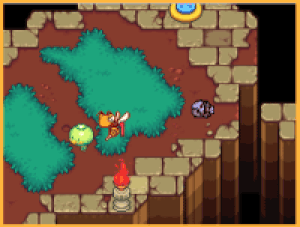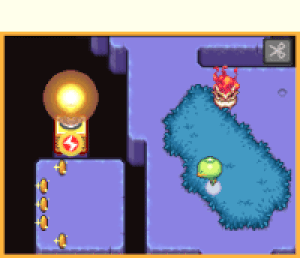
In case you don't know what a kappa is (and we certainly didn't until we first heard of this game), know that it is a mischievous water sprite from Japanese mythology prone to eating small children (and cucumbers – hence the "kappa maki" found in Japanese sushi restaurants); now residing on the DSi.
A product of internal Nintendo studio Brownie Brown, Inc., Kappa Michi combines aspects of platform and puzzle games with great success and includes enough nice extras that you'd think you were playing a full retail release. Control is entirely via the stylus and touch screen, including the main menu which uses the same mechanic used to play the game: drawing a path for "Kappa-san" to follow. The multi-screen menu area is underwater (the kappa's natural habitat) and acts as sort of training area where you guide Kappa-san to different menu choices represented as parts of the background. You move Kappa-san down to the bottom to access extras and three mini-games or swim to the surface through an illuminated portal to play the main game.

The main game sees Kappa-san start out at one end of an elevated platform that stretches away off the top of the lower screen to a water pool which is the goal. On the way you need to trace a path for him to follow, attempting to pick up as many coins as possible; avoiding enemies along the way. After a few moments a disembodied demonic hand will rise from the pool Kappa-san exited and begin following his path adding some pressure to your journey. If the hand catches Kappa-san it whisks him away and he loses one of his three lives, so you'll constantly need to plan ahead to keep some distance between him and the hand. Kappa-san will follow the path wherever you draw it, so you need a steady stylus on some of the winding paths to ensure he doesn't end up walking off into the abyss surrounding the platform. You can change course if required or click the scissors icon to abort the current path, stopping Kappa-san in his tracks. A map of the level appears in the top screen along with the number of coins collected, lives remaining, a 3-heart life gauge and the "line metre," which indicates how long a line you can draw.
Helping Kappa-san are little kappas found in various places, sometimes indicated by small circular depressions in the ground. There are several varieties in different colours: blue ones will dig up some coins or a cucumber to increase your life gauge by one heart, green ones will give you a cucumber to restore one heart, purple ones will stretch out over gaps to allow you to access "islands" near the main platform, black ones follow you and will attack and destroy minor enemies you encounter, yellow ones light up darkened areas and red ones will destroy the demon hand for a limited time (there's a grey one as well, but we didn't encounter it). In order to dig up buried kappas (green and purple) you simply pause at the depression. Blue ones tend to be hidden, so you'll just have to find them by chance. Yellow ones are indicated by stars in the ground and black ones are found in rocks which magically appear in certain areas to block Kappa-san's path and need to be destroyed by tapping them five times. The red mini-kappa is the most useful for getting that hand off your back and floats by on balloons which must be tapped 40 times in order to release him before he drifts off the screen.

The purple kappas are required to get bonus coins and also reach the exit in many levels. The fourth level presents a rather harrowing challenge where you need to open a locked door and will not only be pursued by the demon hand, but have to evade massive demons that spit fireballs at you. Once completed a new portal will appear at the surface of the water, though it's not clear how many levels are ultimately available for play.
Aside from the little kappas there are hidden coins to find and special trigger plates that make more coins appear. The coins act like your score and are also used to purchase music tracks and lovely watercolours from a shop in the bonus area of the underwater main menu. You can also enter Kappa-san's house from this area, where you can view the art you've purchased, listen to the music or review your scores.
Three bonus games are accessed via chests on the bottom of the main menu, though only one is initially unlocked. This first game works much like the main game, but it takes place on one screen and presents players with a grid featuring a few numbers. You need to trace a path from start to goal hitting all the numbers in order along the way. Complicating this is the fact that the grid you're walking across is composed of blocks that drop away, so you need to keep Kappa-san moving lest he fall into an abyss, and he clearly cannot retrace his steps. There's a speed-up item that can be picked up along the way, but mostly you need to rely upon careful planning as the two numbers of the first stage increases to five. There are 12 stages in all and it's simple, yet challenging enough to be a DSiWare game all on its own. We didn't unlock the other two bonus games, but from what we've seen they are a single screen coin collecting game with the demon hand in pursuit of Kappa-san and some kind of maths game in a sushi restaurant with plates of different colours where you're trying to correctly total the bill for the number of empty plates shown.

That's a lot of content for only 500 points, but the icing on the cake is the level of detail the developers have put into the game. Kappa-san is amusingly expressive: exclaiming in fear when the demon hand appears, wobbling when walking narrow pathways and jumping for joy when he gets a bonus. There are quite a lot of watercolour-styled stills of excellent quality and the soundtrack is also lovely (we especially enjoyed the music which plays when you're going up and down underwater shafts to play a stage of the main game or going to Kappa-san's house). The music player is represented as a cassette-tape playing boom box with the songs displayed as different coloured cassettes that are inserted when you tap them. When you go to the underwater shop to purchase music or art you're presented with a virtual coin-operated vending machine with a twist handle - the kind you'd buy sweets from at a shopping mall - and you trace a line around it to "twist" the handle to get your randomly-selected prize which pops out of a virtual plastic ball.
It's such a nicely crafted game with broad appeal that it would be a shame for it to remain in Japan. Thankfully someone at Nintendo agrees and we were pleased to see it appear on the updated release schedule for North America so everyone will get a chance to enjoy this game's charms before the year is out.
Comments 17
Aww, why? I love Brownie Brown, so why does this have to be on the DSi???
i'm disappointed in you. the Kappa is actually the inspiration for th now more famous Koopa
Actually, in mythology, a Kappa is a very very large turtle with an island on its back in place of a shell.
And yes, they eat chirrens and cucumbers.
@3: Noooo, I'm pretty sure a kappa is the same size as a child; it would be difficult to live in rivers and ponds with an island on their back....
And while cucumbers are their favourite food, they are fond of human children (though they eat adults too) whom they eat by sucking something out of their anus.
EDIT: The all-knowing Wikipedia proves me right.
I first learned about Kappa from Final Fantasy III.
^ Likewise. It's a shame Squenix kept retranslating that status effect as "Imp" in the US releases, even the superior GBA script. It's rare to see a kappa as a protagonist, though, so this would be a neat title to see localized.
Third TMNT movie anyone?
Wait... so this isn't coming to N. America?
I saw this on the JPN Nintendo site and absolutely loved it, I hope it comes eventually.
Kappa? Come on, anyone here play Animal Crossing?
Kapp'n always mentions cucumbers in his songs in the GameCube version _
Kappas actually stay completely submerged until they attack. They can then be incapacitated by somehow dislodging the water from the bowl-like depression on the top of their head. This is often done by tricking the semi-inteligent kappa into bowing.
I gotta feeling this will be the best 500 point DSiWare game for quite awhile, right up there with Starship Defense and a few others. That is, if it gets localized.
@Super-Peach Nothing's been sid either way, but, to give you an idea of where it i right now, on Brownie Brown's official site, it lists this game as "Japan Only", though it only lists this on the English translated section, as if they're trying to give us a hint
now i need a dsi and for the game to come to the n/a
The Pokemon Lombre is based on a kappa.
Oh I want this D:
I want this. I can't describe just how badly I want this.
Awesome. Adventure, action, fun minigames..Sounds like my kind of game!
Tap here to load 17 comments
Leave A Comment
Hold on there, you need to login to post a comment...